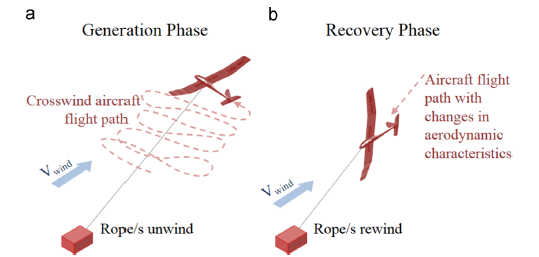Probleemstelling:
Airborne wind energy (AWE) is an emerging and potentially disruptive technology that aims at converting wind energy by flying crosswind patterns with a tethered flying device, e.g. fixed wing or kite (See Figure 1). It has the potential to increase the wind energy yield by capturing wind energy at locations and heights unreachable for conventional horizontal-axis wind turbines. This technology can thus have a strong impact on the transition to a sustainable energy system by generating more green electricity, with higher availability and at a lower cost, which is some of the main limitations today.

Figure 1: Two phases of a ground generation AWE system. [source: Airborne Wind Energy Systems: A review of the technologies. Cherubini A. et al.]
AWE systems could also be combined with HAWTs, by installing the AWE system on top of the HAWT, creating an additional layer in a wind farm and increasing the power produced per square kilometer (see Figure 2). Currently, no detailed simulations or research is done for this configuration. In the literature, it is however mentioned that such configuration can have beneficial effects for the performance of the AWE system [1] as its cosine efficiency can be improved by operating at a lower elevation angle. Furthermore, tether drag and mass are decreased by the shorter tether length. The challenges involved, being the effect of the wake of the wind turbines and the effect of additional loads and vibrations induced in the HAWT tower by the AWE system, need further fundamental research and need to be assessed thoroughly. In this thesis the focus will be on analyzing the effects of the wake.
Figure 2: Artist's impression of AWE devices installed on top of HAWTs
References
[1] F. Bauer et al. Crosswind kite power with tower. Airborne Wind Energy -- Advances in Technology Development and Research, 441-462, 2016.